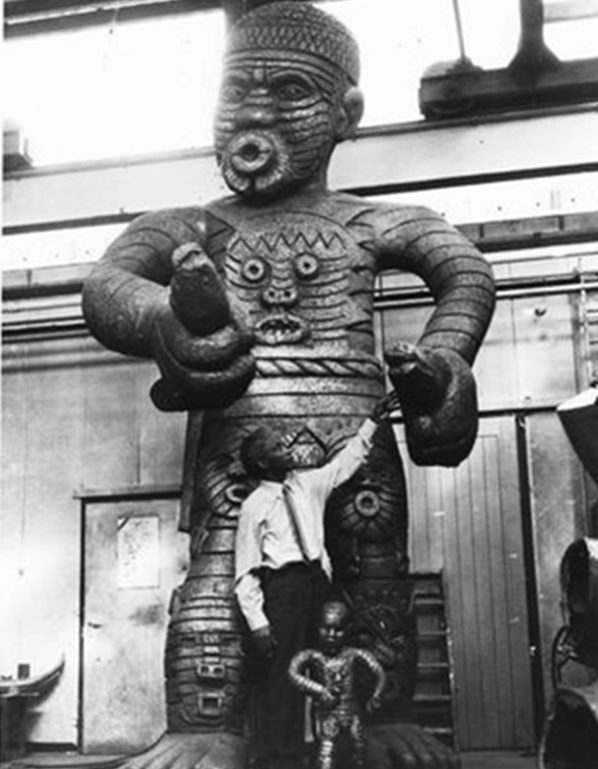
This time Charles spoke slowly with perplexity characterising his tone: “You know? Denis’s birth centenary is tomorrow.” Needless to say, I was surprised. I asked him to repeat, thinking I had misheard him. I asked whether he was absolutely sure. How could this be? I had heard nothing from the institutions Williams founded and this was Charles’ worry. “Yes,” he said and explained how the memory came to him. Indeed, when I checked, had Williams not transitioned to be with the ancestors on June 28, 1998, he would have been 100 years old on February 1, 2023.
My knowledge of Williams’s work in art at the time of the revelation was admittedly typical. It is now modestly less so, thanks to the substantial material written about him despite their scattered locations. Nonetheless, I suppose I knew the usual things about Williams: polymath; British Council Scholar; studied and successfully showed work in London; his painting Human World was featured in Time Magazine in 1950. Human World was bought for the Guyana National Collection through public subscription.
Along with many, I knew of Williams’s influence on British-trained Lokono printmaker-turned-painter George Simon’s (1947 – 2020) shift to ground his work in his and the related cultures of his origins. Simon later conducted workshops with the support of at least one artist-colleague at St Cuthbert’s Mission/Pakuri Village out of which the Lokono group of artists emerged. Thus, a line of connectivity between Williams and the Lokono artists through Simon can be drawn. I suppose less commonplace, is the fact that Stanley Greaves (b. 1934) was among the first on this soil to see Human World as it was uncrated at the Queen’s College by E R Burrowes after its glorious debut to the world on the magazine’s cover.
In the realm of common knowledge, Williams was quite a formidable figure for young students of art. As a student at the E R Burrowes Art School (BSA), which he founded in 1975, I recall a visiting alumnus asking me whether Williams taught me or had seen my work. I understood from ‘Denis’s former student’ that my instruction was only complete if Williams had a part to play and the merit of one’s work was best assessed by Williams. But students at the art school during my time could only imagine who this man was as by the time we ventured into the inner sanctum of the Carmichael Street location, he had long relinquished the day-to-day responsibility for the school to Agnes Jones AA (1921 – 2008). Nonetheless, perhaps shared by my cohort, was a sense that even though Williams was ensconced at the Walter Roth Museum of Anthropology a mere stone’s throw away, one’s progress and the institution would be known and monitored. I was not one of the fortunate to be taught by Williams. The good instruction that he dispensed to students was never mine to benefit from and even though I knew very little about him, I felt disadvantaged.
“Whatever Denis said, that was it,” is an often-cited remark by Charles whenever he speaks of Williams. Charles’s statement is usually in relation to the freely dispensed guidance he received in relation to the progression of early work. But the statement appears apt in summarising the general regard for Williams’s perspectives. Perhaps most notable would be the tide change he effected on the initial reception of Moore’s Cuffy in the 1763 Monument by the Guyanese public. While the esteemed men and women of the day initially derided the work, Williams justified and lauded it. In essence, Williams challenged the colonial blinders to vision. He wrote:
“This image goes beyond merely illustrating revolution in being itself a revolution in vision. Philip Moore’s [1921 – 2012] spectators need equally a revolution of vision in themselves in order to understand this work. When we look back at this monument we will see that it is truly historical not only in symbolising 1763, but also in being the watershed that offered a new image of ourselves and so a milestone in the cultural revolution which freed us from self-doubt and self-contempt implanted in our peoples during the nineteenth century. […]” (quoted by E Williams in The Art of Denis Williams, p.118)
Wiliams’s contribution to art has been documented by his contemporaries, substantially researched by his daughter Eve Williams in her 2012 text, The Art of Denis Williams, and by other scholars. His contributions in other fields of intellectual pursuit have also been documented, in some cases by Willams himself. What remains outstanding, however, is for this wealth of information on Williams to be collected in a single location to aid further research into his contributions to the intellectual and cultural life of Guyana. At this junction, as the National Gallery of Art, Castellani House appears to be without robust programming and as it is the appropriate and necessary thing to do, the gallery will not only serve itself well but those of us with a penchant for art to pull out of storage the few works that are in its collection by Williams to display alongside the books and other documents he penned or which were penned about him during his lifetime and since his passing. Since the works in the National Collection are few, there are innovative ways of showing other works from his oeuvre (body of work) within such an exhibition. At the National Archives of Guyana are wonderful finds (newspapers) dating back to the announcement of his scholarship and chronicling his success in London, his return to British Guiana, and his subsequent departure after encountering an unreceptive audience for his newer approaches here. Perhaps, these and the other documents alongside his quartet of lectures collectively titled “Image and Idea in the Arts of Guyana” from his January 1969 Edgar Mittelholzer Memorial Lectures could form part of this exhibition.
Akima McPherson is a multimedia artist, art historian, and educator




